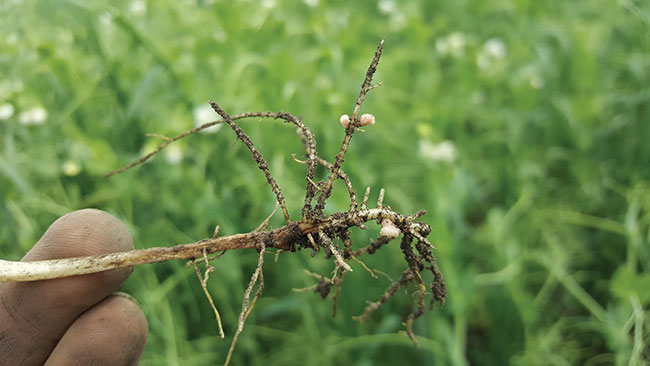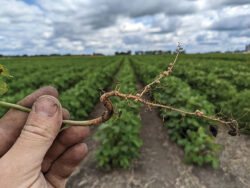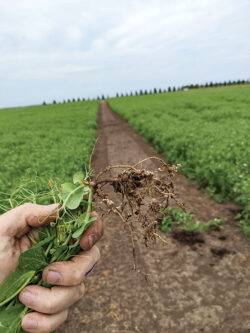
Features
Agronomy
Fertility and Nutrients
Making the most of your rhizobial friends
Figuring out ways to maximize inoculant benefits to legume crops.
October 30, 2023 By Carolyn King
 Many rhizobia in most soils can form symbiosis with peas, so Geddes is assessing the competitiveness and effectiveness of natural rhizobia strains.
Photo courtesy of Barney Geddes, North Dakota State University.
Many rhizobia in most soils can form symbiosis with peas, so Geddes is assessing the competitiveness and effectiveness of natural rhizobia strains.
Photo courtesy of Barney Geddes, North Dakota State University. Rhizobial inoculants are a key part of legume crop production, helping to boost crop growth and yields by providing nitrogen to the crop. Now, Barney Geddes, an assistant professor in microbiological sciences at North Dakota State University, is working to further improve the crop benefits from inoculation.
He and his research group are delving into how to more accurately predict when farmers can expect benefits from inoculation, assessing the natural rhizobia community in the soil and exploring the potential to tailor inoculants to specific situations.
As legume growers know, rhizobia are soil bacteria that can form nodules on the roots of their legume host. In the nodules, the rhizobia “fix” nitrogen – convert gaseous nitrogen from the soil pores into nitrogen compounds that the plant can use. In return, the rhizobia receive some of the carbohydrates that the plant has made through photosynthesis.
Only specific rhizobial species can form this symbiotic relationship with a particular legume species. Strains in inoculants have been selected to be really good at providing nitrogen to their target legume species.
When to inoculate
After an inoculated legume crop is harvested, rhizobia from the inoculant will persist in the soil for a while even without a host crop. But will there be enough of those residual rhizobia so that you won’t need to inoculate the next time you grow the crop?
Geddes explains that the number of residual rhizobia is influenced by the number of years that have passed since the legume last grew, and by the soil and weather conditions. For instance, conditions such as drought, flooding, acidic soils, iron deficient soils or saline soils can reduce rhizobia populations.
Results from field trials on inoculant response in different regions offer general guidance to local farmers about when to inoculate. The North Dakota guideline is that farmers in the state can go about five years between soybean crops before inoculating again.
“However, we’d like to get a much deeper understanding of exactly what happens with inoculants after they have been applied and to their populations,” says Geddes. “That would help us get a more sophisticated and accurate level of agronomic understanding for making recommendations to farmers to inoculate or not.”
To help build this deeper understanding, Geddes and his research group have been developing PCR tests to measure pea, soybean and chickpea rhizobia populations.
Although PCR tests for pea and soybean rhizobia already existed, Geddes and his group have created new versions that they think are more accurate.
“The PCR test measures the rhizobium DNA. We designed the test specifically to measure the number of symbiotic genes [of the target rhizobia species] in a soil sample,” he says. “That ensures we’re only measuring the rhizobia that actually form the symbiosis with the target crop and not some other sort of bacteria that might be related to the rhizobia but are not able to form that symbiosis.”
Since peas, lentils and faba beans all form symbiotic relationships with the rhizobia subspecies called Rhizobium leguminosarum biovar viciae, the pea PCR test can be used for all three legumes. The soybean test is for Bradyrhizobium japonicum.
His group has also developed what Geddes thinks is the first-ever PCR test for chickpea’s rhizobia species, Mesorhizobium ciceri.
Intriguing regional differences
One way Geddes and his group are using PCR tests is to measure rhizobia population levels across North Dakota to see how quickly the residual populations decline.
Their biggest finding so far is that the populations in western North Dakota seem to decline much faster than the ones in eastern North Dakota.
“In eastern North Dakota we have this Red River Valley soil that is very fertile and gets a lot of rainfall. The western half of the state has much drier conditions with lower soil moisture,” he notes.
Interestingly, a sample from an irrigated field in western North Dakota maintained pretty high rhizobia populations, suggesting that low moisture could be a driver for the rapid population decline in the dryland locations in the west.
Inoculation recommendations
Geddes is looking into the possibility of using these PCR tests for making inoculation recommendations to farmers.

Geddes is leading field and greenhouse studies in soybeans and other legumes to determine rhizobia population thresholds for inoculation.
Photo courtesy of Barney Geddes, North Dakota State University.
“I know that in many cases farmers would like to just receive some general advice about when to inoculate,” he says. “But if a farmer is focused on a precision agriculture approach, with very data-driven decisions on the farm, we would like to offer the tests as a service where we could measure and advise on the rhizobia population in given fields.”
His hope is that these tests can be done for a moderate additional cost in soil testing labs, as part of the soil nutrient testing that farmers already have done.
This year, with funding from the North Dakota Soybean Council, Geddes’s group is looking into sample handling options. They want to compare the PCR results when the samples are handled the way farmers would usually handle samples for soil nutritional analysis, and when the samples are handled following the best practices for DNA tests, like keeping the samples frozen.
Geddes and his group are also working on the challenge of relating measured rhizobia populations to thresholds where, above a certain population level, inoculation doesn’t result in increased nodulation or higher crop yields.
As part of this threshold research, they have been working with Research Extension Centers across North Dakota. Together they have selected fields in diverse locations that likely have either high levels or low levels of rhizobia, based on the field’s agronomic history.
In these fields, they are doing inoculant trials to see if they can define the population thresholds. Last year, they studied thresholds for peas and chickpeas, and this year they are studying thresholds for soybeans.
Since rhizobia population levels are not the only factor affecting inoculant success, Geddes and his group are also examining the impacts of characteristics like soil pH and soil nitrogen levels in this research. (When soil nitrogen levels are high, a legume will tend to use the soil nitrogen rather than forming a symbiotic relationship with rhizobia.)
The researchers are doing greenhouse experiments to get a more precise understanding of the thresholds. “We add very exact amounts of rhizobia in a gradient from maybe one cell per gram [of soil] all the way up to maybe one million cells per gram, and try to see when the crop is benefitting or not benefitting any further from additional rhizobia,” he explains.
The preliminary results from their threshold studies indicate there are probably large differences in the thresholds from crop to crop.
“We found that peas didn’t seem to need many rhizobia at all. Even when very few rhizobia were present, peas were pretty good at forming root nodules and fixing nitrogen. On the other hand, chickpeas seemed to really benefit from having larger rhizobia populations,” says Geddes. “So, these experiments might give us some insight that maybe there are certain legumes farmers don’t need to inoculate and some legumes farmers should be inoculating all the time.”
Inoculant rhizobia vs. resident rhizobia
In addition to rhizobia applied in inoculants, there are also rhizobia residing in the soil, some of which can form symbiosis with legume crops.
“The issue is that there is a lot of variation in those natural rhizobia populations,” says Geddes. Some strains might be really good at providing nitrogen to the crop and boosting crop yields. But others might give little or no benefit to the crop.
Some of the resident rhizobia could be residual rhizobia introduced by previous inoculations. These leftover rhizobia might provide just as much benefit to the crop as the original inoculant. Or they might have adapted to the local environment and now provide lower benefits to the crop and greater benefits to themselves. Other rhizobia in the soil might be native species that associate with native legumes but can also form symbiosis with the crop legume. Still, other rhizobia might be able to form nodules on the crop legume’s roots but do not have a symbiotic relationship with that legume and do not provide nitrogen to it.
On the Canadian Prairies and the Northern Great Plains in the U.S., many rhizobia in most soils can form symbiosis with peas, and the same is true for alfalfa. However, native rhizobia strains that form symbiotic relationships with soybeans are much rarer due to this crop’s recent introduction in the region.
Resident rhizobia that can nodulate a legume crop compete with the inoculant rhizobia for places on the roots. A plant might have some nodules with inoculant rhizobia and some with resident rhizobia.
Legume growers know to check that root nodules are pink inside to be sure that nitrogen fixation is occurring. “What that pink colour might not indicate is how efficient that process is,” notes Geddes “You might have two pink nodules and one could be doing a great job at providing a lot of nitrogen and the other could be providing much less.”
Geddes and his group are currently conducting research to get a better handle on the characteristics of resident rhizobial strains in North Dakota. With funding from the Northern Pulse Growers Association, they have amassed a collection of more than 1,000 pea-nodulating rhizobia from across the state, spanning a wide range of soil types.
They have found an astonishing amount of diversity in this collection. “Let’s say we collect 20 pea-nodulating rhizobia from a field. All 20 are almost always different strains. That tells you there is an enormous diversity in the natural rhizobia out there,” he says.
Competitive, effective or both?
Ideally, an inoculant strain should be very effective at providing nitrogen to the plant and also competitive so it can beat out all the resident rhizobia for a place on the root.

Through field and greenhouse studies, Geddes is assessing the competitiveness and effectiveness of natural rhizobia strains.
Photo courtesy of Barney Geddes, North Dakota State University.
Geddes and his group are assessing the competitiveness and effectiveness of the strains in their collection of pea-nodulating rhizobia. They are using a variety of methods to do this work, including some high-throughput methods that are accelerating the pace of the analysis. When Geddes was a post-doctoral researcher at Oxford University a few years ago, he was involved in developing the high-throughput method his group is now using to screen strains for effectiveness.
Their initial results from these assessments are pretty interesting. “Number one, competitiveness and effectiveness are definitely not linked traits. In other words, a competitive rhizobium is not necessarily effective, and an effective rhizobium is not necessarily competitive,” says Geddes.
“Overall, when we look across the rhizobia that we have collected, at least in peas where we have done most of the work so far, we find a complete gradient from totally ineffective rhizobia to really, really effective rhizobia. And within that gradient, there are competitive strains throughout.”
Unfortunately, many of the ineffective strains are really competitive.
But fortunately, they have found a few strains are both effective and competitive, and might make good inoculant strains in the future.
Tailored inoculants
An inoculant strain is typically one that performs well with the target legume species under a range of growing conditions. But is that strain the best for a specific cultivar growing in a particular region?
“I strongly believe it is possible to get boosts in legume yield and performance by tailoring the inoculant to both the cultivar and the soil. We’re actively doing a lot of research to show the proof-of-concept of that,” says Geddes.
“In my opinion, that is really the future of this industry. It is obviously easier, from a commercial standpoint, for a company to produce one product and sell it all over the world. But my hope is that we would be able to see enough improvement in the technology by doing this tailored approach that it would be sufficiently profitable for companies to produce a variety of inoculants that are expected to perform with a particular cultivar or in a particular area.”